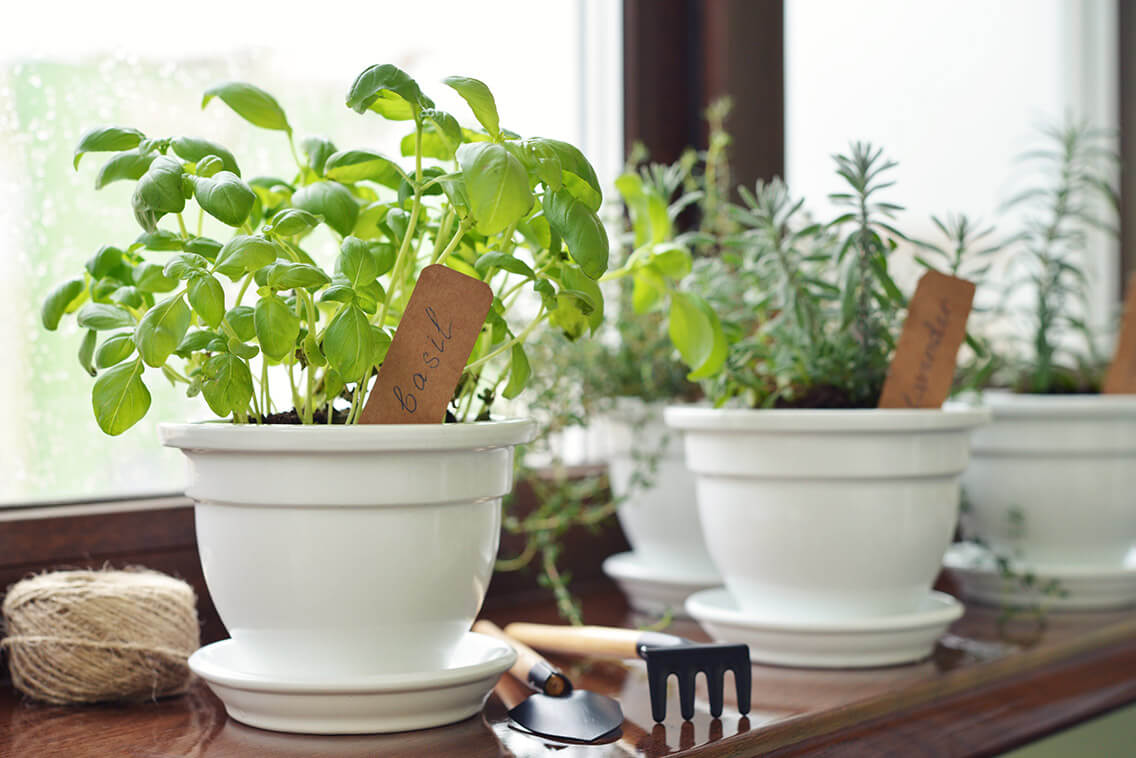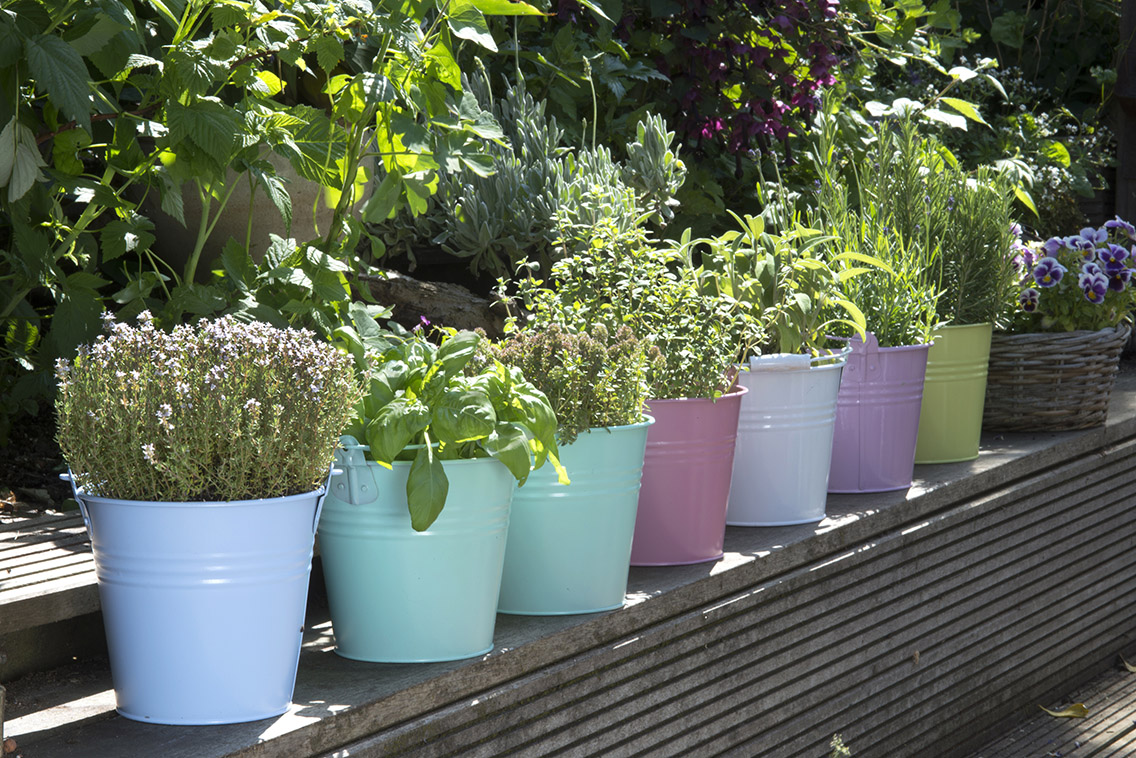Don't let a lack of acreage stop you from flexing your green thumb. Our potted-plant primer makes it possible to garden just about anywhere.

[mf_h2 align=”left” transform=”uppercase”]Does the Container Matter?[/mf_h2]
There are hefty price differences among pots. You might think that a beautiful terra cotta or galvanized steel container possesses superior horticultural powers. You’d be wrong. “It’s not really going to make a difference,” says Sheperd. If you want an expensive glazed ceramic pot because it looks great, fine, but Sheperd actually recommends a cheap all-purpose bucket of the sort you can get at Home Depot for under $3. (More on that below.)
The key to successful container gardening is not the container’s material, but its size. “Bigger means more soil volume, which means more root mass, which means the roots can hold more nutrients and water,” says Sheperd. Furthermore, different plants have different needs. In general, herbs, greens, and lettuces require minimal space. But each tomato, pepper, zucchini, cucumber, or bean plant should get its own 5-gallon container.
[mf_h2 align=”left” transform=”uppercase”]How to Trick Out Your Container[/mf_h2]
The reason Sheperd prefers a cheap all-purpose bucket is because she gets to determine the location of the drainage holes, by drilling a few around the sides, several inches up from the bottom. (Traditionally, drainage holes are located on the pot’s bottom.) To create a reservoir at the bottom of the bucket, she pours in regular chunky gravel just above the level of the holes, then lays down a layer of weed-block fabric before adding soil, to prevent the soil from clogging the reservoir. The end result: The plant remains well-irrigated, and you water it less.

A mix of herbs in colored buckets in garden. Shutterstock/Anjo Kan.
The organic seeds packets included with some Seed Phytonutrient products – sweet basil, harvest thyme, and lemon basil – can all be grown in containers. Give it a shot!
[mf_h2 align=”left” transform=”uppercase”]But What About the Soil?[/mf_h2]
Though Sheperd builds her own soil with coconut husks, cow manure, and all kinds of other things, she says you can certainly make due with a good bagged organic mix. She also recommends using organic fertilizer: compost if you have access to it, or an off-the-shelf version. “Dr. Earth is a good fertilizer brand,” says Shepherd, who warns against applying too much. “Over-fertilizing is just as bad as under-fertilizing. I tell people to think of it like salting soup.”
[mf_h2 align=”left” transform=”uppercase”]Okay, So What Should You Grow?[/mf_h2]
“If you’re gardening in containers, then your limiting factor is probably space,” says Shepherd, “so I would focus on plants that produce a lot per square foot.” Translation: Root vegetables; carrots, beets, onions, and radishes aren’t a great bet, because one seed equals one vegetable. Compare that with peppers, lettuces, herbs, and flowers like calendula and zinnias, which you can pick multiple times per season. Most herbs will also live happily inside come winter, in a sunny, south-facing window.
[mf_list_sidebar layout=”basic” bordertop=”yes” title=”Herbs You Can Move Inside for the Winter” separator=”no”]
[mf_list_sidebar_item]Basil[/mf_list_sidebar_item]
[mf_list_sidebar_item]Oregano[/mf_list_sidebar_item]
[mf_list_sidebar_item]Chives[/mf_list_sidebar_item]
[mf_list_sidebar_item]Marjoram[/mf_list_sidebar_item]
[mf_list_sidebar_item]Thyme[/mf_list_sidebar_item]
[mf_list_sidebar_item]Mint[/mf_list_sidebar_item]
[mf_list_sidebar_item]Rosemary[/mf_list_sidebar_item]
[mf_list_sidebar_item]Lemon Balm[/mf_list_sidebar_item]
[mf_list_sidebar_item]Lemon Verbena[/mf_list_sidebar_item]
[mf_list_sidebar_item]Lavender[/mf_list_sidebar_item]
[/mf_list_sidebar]
[mf_h2 align=”left” transform=”uppercase”]How to Water a Container Plant[/mf_h2]
Never, ever drizzle water over the top of the plant: If the leaves get and stay wet, they can develop mold and other problems. Instead, water the plant at soil level. Adds Shepherd: If you have a hose nearby, it’s worth it to put in an inexpensive irrigation system.”
[mf_h2 align=”left” transform=”uppercase”]A Final Note on Proper Placement[/mf_h2]
“When I’m helping someone set up a container garden, the first thing I look at is sunlight,” says Sheperd, who prefers south-facing light because it shines brightest in the morning. Harsh, broiling afternoon sun can burn plants and evaporate water too quickly. In containers, the problem is amplified, adds Shepherd: “There’s less soil volume, so things do dry out more quickly.”
Love & Carrots is a DC-based home gardening company that helps urbanites set up gardens in the strange and difficult spaces.